| (insert your NIE or newspaper logo here) |
Weekly Online LessonOnline Lesson ArchiveGrade Level: 6-9
|
A Whale Of A Study
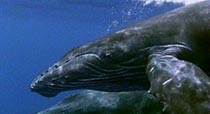 Over the next four months, researchers hope to see more humpback whales in the North Pacific Ocean than have been spotted there in a long time.
Over the next four months, researchers hope to see more humpback whales in the North Pacific Ocean than have been spotted there in a long time.
Humpback whales are believed to make the longest migration of any mammal -- as many as 5,000 miles one way. These whales swim into northern waters to spend the summer, then return to the southern hemisphere for the winter.
In the 1960s, researchers estimated that only about a couple thousand humpbacks -- a fraction of their historic numbers -- still roamed the Pacific. Those studies concluded that nearly a century of commercial whaling had decimated their populations. In 1970, the humpback gained protection in American waters under the Endangered Species Act. The International Whaling Commission also protects them.
Beginning Saturday, June 26, 2004, researchers will collect data to determine if those protections have helped the regional population rebound. To estimate their numbers, researchers will survey the coasts along British Columbia, Alaska, Russia, and the south Bering Strait.
This four-month mission is part of a three-year, $3-million, multinational study paid for by the U.S. National Oceanic and Atmospheric Administration. Joining American scientists and volunteers will be others from Japan, Russia, Mexico, Canada, the Philippines, Costa Rica, Panama, Nicaragua, and Guatemala.
Researchers believe that the humpback population has surpassed 10,000, growing by at least 6 to 8 percent annually. Observations and identifications made during the mission will help support or dispel that theory. While they're at it, experts also hope to learn more about how the whales live, behave, and communicate.
This week, you'll get some training as a whale biologist, and learn about the kinds of things these researchers will do and see over the next four months.
A World of Whales
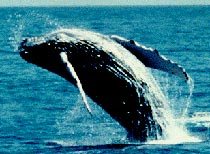 Start your whale training in St. Lawrence, Quebec, at Whales On-Line. Although this site is based on whale populations in the Atlantic Ocean, rather than in the Pacific, it is still useful for understanding whale basics.
Start your whale training in St. Lawrence, Quebec, at Whales On-Line. Although this site is based on whale populations in the Atlantic Ocean, rather than in the Pacific, it is still useful for understanding whale basics.
Enter Flash site or Enter without Flash. From there, go See the whales and in the pull-down menu, Choose a theme -- Cetaceans or whales?
What does the word "cetacean" mean in Greek? What are the two types of whales, and how exactly do the groups differ?
On the left hand side of the page, click on Biology to discover How whales live. Which particular characteristics distinguish whales as mammals?
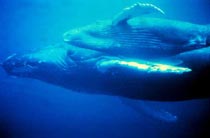 Browse through this section, reading about the Evolution of whales, Communication, Migration, Reproduction, Feeding, The five senses, and Diving Adaptations.
Browse through this section, reading about the Evolution of whales, Communication, Migration, Reproduction, Feeding, The five senses, and Diving Adaptations.
What is the relationship between whales, pigs, and camels? How exactly do whales breathe differently from fish? In what ways are migration and reproduction related? Why do different species feed differently?
Which sense is most important to cetaceans? Which is least important and why? How can whales dive so deeply?
Now let's look at How to identify them at sea. Review the brief facts about each whale, then click on each species' name, including the humpback whale, to read more in-depth information. (Make sure to scroll down the page.)
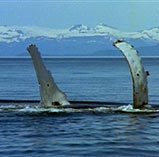 On any of the individual species pages, click on the icon that opens a pop-up window to compare the relative sizes of these whales. Click on the image to see color illustrations of the whales; click again to return to the silhouettes.
On any of the individual species pages, click on the icon that opens a pop-up window to compare the relative sizes of these whales. Click on the image to see color illustrations of the whales; click again to return to the silhouettes.
What are the five biggest species? How do their geographical distributions compare?
Now that you've got the whale basics covered, check out the Techniques researchers use to identify and track different individual whales.
These techniques include Photo-identification, Biopsy, the Carcass recovery network, Telemetry, Marine acoustics, and Aerial surveys.
What kinds of clues does each technique provide researchers to piece together some of the details of how whales live? How do experts use aerial surveys to estimate population numbers?
If you'd like to know more about careers in marine mammal work, meet The whale researchers and find out what it takes to Become a whale researcher.
The Life of Humpbacks
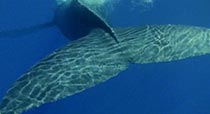 Next, let's focus more specifically on the humpback whale at the PBS/Nature site, Humpback Whales.
Next, let's focus more specifically on the humpback whale at the PBS/Nature site, Humpback Whales.
Read the introduction, then check out the Special Features, The Curious Humpback and Song of the Sea. Make sure to watch the RealPlayer video to hear some of the humpback songs for yourself!
How did the humpback get its name? When did researchers first discover that humpback males produce songs? Do their songs remind you of the ways other animals communicate?
Newspaper Activities
Now and over the next several months, browse Targetnewspaper for articles about the North Pacific humpback whale survey mission, or any other news about humpbacks or other whales. What techniques did the humpback whale researchers use on their mission? Are population estimates more, less, or about what they expected? Are scientists surprised by any new findings about whale biology? Have experts and other whale watchers spotted any feeding, communication, or reproductive behaviors or migration patterns not yet documented?
© Copyright 2004
Learners
Online,
Inc.
